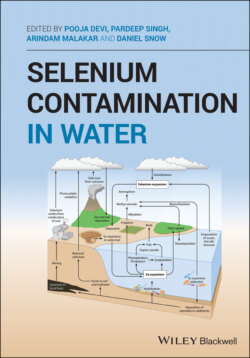Читать книгу Selenium Contamination in Water - Группа авторов - Страница 48
4.1 Introduction
ОглавлениеSelenium (Se), a semi‐metal or metalloid was discovered by Swedish chemist Berzelius in 1818 during the production of sulfuric acid. It was named after the Greek moon goddess, Selene. Se is a semi‐metal as it is present together with oxygen and sulfur and has similar chemical characteristics to S (Lenz and Lens 2009). The atomic number of Se is 34. It produces rotting horseradish odor during heating. In fact, it is not present in nature in its pure form. It is found in water in the form of selenites and selenates. This is a trace element because it constitutes just 0.00008% of the Earth's crust (Bennett 1983; Bednarek and Bik 1994).
Selenium (Se) is being an essential micronutrient (Lu and Holmgren 2009) required for livestock animals for better cardiac and skeletal muscle growth, fertility, immune status, anticarcinogenic, antiviral, anti‐inflammatory, chemopreventive, antiparasitic, etc. (Leibovitz et al. 1990; Rayman 2000; Guisbiers et al. 2016; Peng et al. 2016; Stolzoff and Webster 2016; El‐Ghazaly et al. 2017; Guisbiers et al. 2017; Maiyo and Singh 2017). It has now become toxic due to poisoning, selenium injection, fodders grown on selenium‐toxic land, and indiscriminate minerals supplementation feeding. As early as the 13th century, the toxicity of Se was reported for the first time by Marco Polo, who found hoof disease and hair loss in horses due to toxically high levels of Se accumulated from plant consumption. In addition, Se is the most important constituent of the body's antioxidant defense mechanism through selenoproteins such as GPx (Hefnawy and Tórtora‐Pérez 2010; Pascual and Aranda 2013). Despite all these useful qualities of Se, it causes several disorders in domestic animals after consuming high doses. The main sources of Se for livestock animals are soil, water, forages, and feed supplements. Coal‐mining regions mainly contain a higher level of Se due to the presence of pyrite oxidation (Dreher and Finkelman 1992). The level of Se varies from state to state and from country to country (Dhillon and Dhillon 2003; Lenz and Lens 2009).
The presence of Se in groundwater and surface water mainly depends upon the characteristics of soil, and anthropogenic factors relating to that area (Giri 2019). The underground water of a seleniferous region showed 2.54–69.53 μg/l of Se, whereas a non‐seleniferous region was characterized by 0.25–8.63 μg/l (Dhillon and Dhillon 1991). Soil is the main source for the higher accumulation of Se in forage (Lakin 1972; Wu et al. 1988; Harada et al. 1989; Stephen et al. 1989; McQuinn et al. 1991). Feed supplements also caused selenosis in livestock animals. Wahlstrom and Olson (1959) and Wilson et al. (1982) reported a focal symmetrical poliomyelomalacia after administration of a Se supplement in swine but chronic selenosis in cattle, sheep, and horse was rare after a Se supplement in feeds. Therefore, diagnosis of Se in soil, forages, and in livestock animals should be executed properly. The primary source of Se for plants is soil followed by water. Se uptake by plants mostly depends upon the soil’s physico‐chemical properties and basically the pH of the soil determines the Se uptake by plants. If a plant has the capability to uptake Se (i.e. seleniferous plants), then it will accumulate higher Se. The nature of the soil defines the Se availability to plants. It has been found that Se uptake is higher in heavier‐textured soils that in clay‐type soil. The heavier‐textured soils promote Se uptake by plants. The pH of the soil is also important for Se uptake by plants. A study reported that high soil pH will increase the leaching of Se toward the sub‐soil from the top soil. Therefore, when examining Se availability in the soil, it has been well documented that soil should be tested for pH level and the soil samples should be taken at different depths according to the pH (Davis et al. 2000).
Higher levels of Se exposure triggered alkali disease and the effect of selenium toxicity was blind staggers (National Research Council [NRC] 1983). The higher Se level triggered three forms of toxicity primarily: acute, sub‐acute, and chronic toxicity. Animal poisoning is described as being acute, sub‐chronic, or chronic (National Research Council [NRC] 1983). A lot of factors control the selenosis in an animal’s body, such as the properties of Se and animal health properties. It was also found that selenosis varies from species to species of livestock animals (horses > cattle) (Ehlig et al. 1968; Rosenfeld and Beath 2013). Sub‐chronic and chronic Se toxicity causes pathological changes mainly in skeletal muscle, heart, liver, spleen, and kidney as Se is mostly accumulated at a higher level in these organs (Rosenfeld and Beath 2013). Therefore, some preventive measurement like agricultural field management, the feeding of high protein‐rich feed, dietary sulfate, methionine supplement, linseed meal, spraying sulfur‐containing materials on fodders grown in selenium‐rich soil, clean water, phyto‐remediation etc. are being implemented to maintain the health and higher productivity of domestic animals (Dhillon and Dhillon 1991). Therefore, this book chapter discusses in detail the sources and mechanism of Se toxicity in the bodies of livestock animal, as well as the probable preventive measures to attenuate Se toxicity leading to better health and higher production of the livestock animals and reduction of selenium in the human food chain through milk and meat intake.
